Literacy Pages: The Series presents the final post of our 8-part series related to accelerating learning in early lessons by developing self-extending systems.
Integrating: to form, coordinate, or blend into a functioning, or unified whole. That is the official definition of integration, according to Merriam-Webster. The ultimate “whole” of learning to read is to read a text of one’s own choosing, understand, derive joy, learn, and synthesize. The fundamental goal is for children to achieve an efficient coordination of attention to all information as they read. Clay (2016) says, “…there are many sources of information in texts. In Reading Recovery lessons, teachers pay particular attention to four kinds of information.” The four kinds of information referred to are these:
- Sense & Meaning
- Visual Information
- Structure & Grammar
- Sounds
These sources of information tend to become lumped together into “MSV.” This would be an oversimplification of the purpose of sources of information within a Reading Recovery program. We may use the code MSV to analyze running records to help find patterns in a child’s reading, but we do not “teach MSV.” We teach children to make “perceptual comparisons and pay attention to more hidden relationships in texts” through massive opportunities to extend their own knowledge. We do this while we simultaneously clear up inaccurate understandings of letter forms, sound associations, and of words (Clay, 2016).
Clay (2016) notes that successful readers naturally bring order and make connections even between things that their teachers’ instruction did not emphasize. She says, “Children who have difficulty with reading have not had that kind of success. The brain work they have tried… has not brought order to the complexity.” The teaching of isolated items such as letters, sounds and words is not enough. Children must quickly become aware of the possibility of exception. “So the links of form-to-sound or sound-to-form must not be taught in ways which monopolize attention and deny the processing system the flexibility to deal with exceptions (Clay, 2001).”
Children can gain experience managing visible and invisible relationships in text. We can call children’s attention to these relationships from early lessons. Clay (2001) suggests the following prompts to help students access visible information and match it up with the invisible:
- Would that make sense? (meaning)
- Can we say it that way? (structure)
- Can we “hear” this letter? (auditory input)
- Does it look right? (visual input)
There are four to five places in a Reading Recovery lesson where a learner can “pull together all the bits and pieces (Clay, 2016).” Each lesson should contain several familiar readings, the reading of yesterday’s new text, the writing of a story, and the reading of a novel text (a new book). Including all of these experiences in every lesson is imperative. According to Clay (2016), when working in continuous text, a child “has to call up things he already knows from different parts of his brain to meet up with the new information in the print he is looking at (the integration of different kinds of information).”
The parts of a Reading Recovery lesson that support integration (Clay, 2016):
Familiar Reading: Repeated opportunities to orchestrate information quickly. Teachers expect the reading to sound like talking and for the child to construct meaning with ease while discovering new features of the text that had not been noticed before. The child has a chance to integrate quickly because the text is familiar. We must be careful to ensure that the child is reading books in which they can sound fluent during this part of the lesson.
Yesterday’s New Book: A teacher’s opportunity to observe how the reading is coming together. Teaching for successful processing is just as important as teaching where there was an error. The teacher can point out to the child where successful processing has taken place to make it more likely to occur again in the future.
New Book: This calls for independent reading with minimal support, solving hard parts, and learning through the teacher’s prompts which will direct the child in how to orchestrate information. The child learns to cope with more features of language. This is the part of the lesson where the teacher can respond to the child’s attempts at novel text to help balance their attention to different kinds of information in order to solve and construct meaning efficiently.
Writing Continuous Text: Writing provides the learner with opportunities to integrate sources of information by frequently switching between different levels: letters, words, phrases and messages. The child moves from simple to complex sentences over time, which will provide them with knowledge of structures they will need in order to integrate during the reading of more complex texts.
The successful and efficient integration of information results from carefully constructed teaching and prompting for the coordination of many sources of information. This is achieved through the vehicle of continuous text in which children gain control of various ways of working with information. “This self-tutoring occurs at faster and faster rates under the control of sound monitoring and self-correcting systems (Clay 2016).” Integration, the efficient orchestration of many sources of information, is a clear sign of a developed self-extending system.
Please find other posts from this series below:
Self-Extending Systems: Teaching with Discontinuation and Independence in Mind
Part 1: Actively Self-monitoring
Part 2: Searching for Different Kinds of Information
Part 5: Making New Discoveries
Part 6: Cross-checking Sources of Information
References:
Clay, M.M. (2016). Literacy Lesson Designed for Individuals. Auckland, NZ: Scholastic.
Clay, M.M. (2001). Change Over Time in Children’s Literacy Development. Portsmouth, NH: Heinemann.
